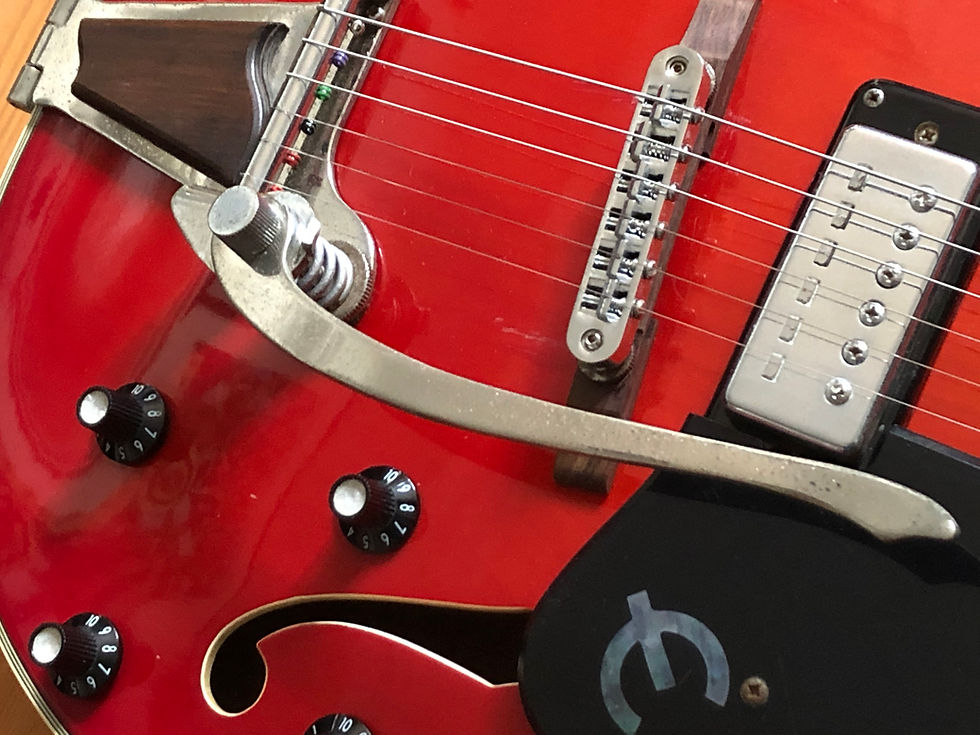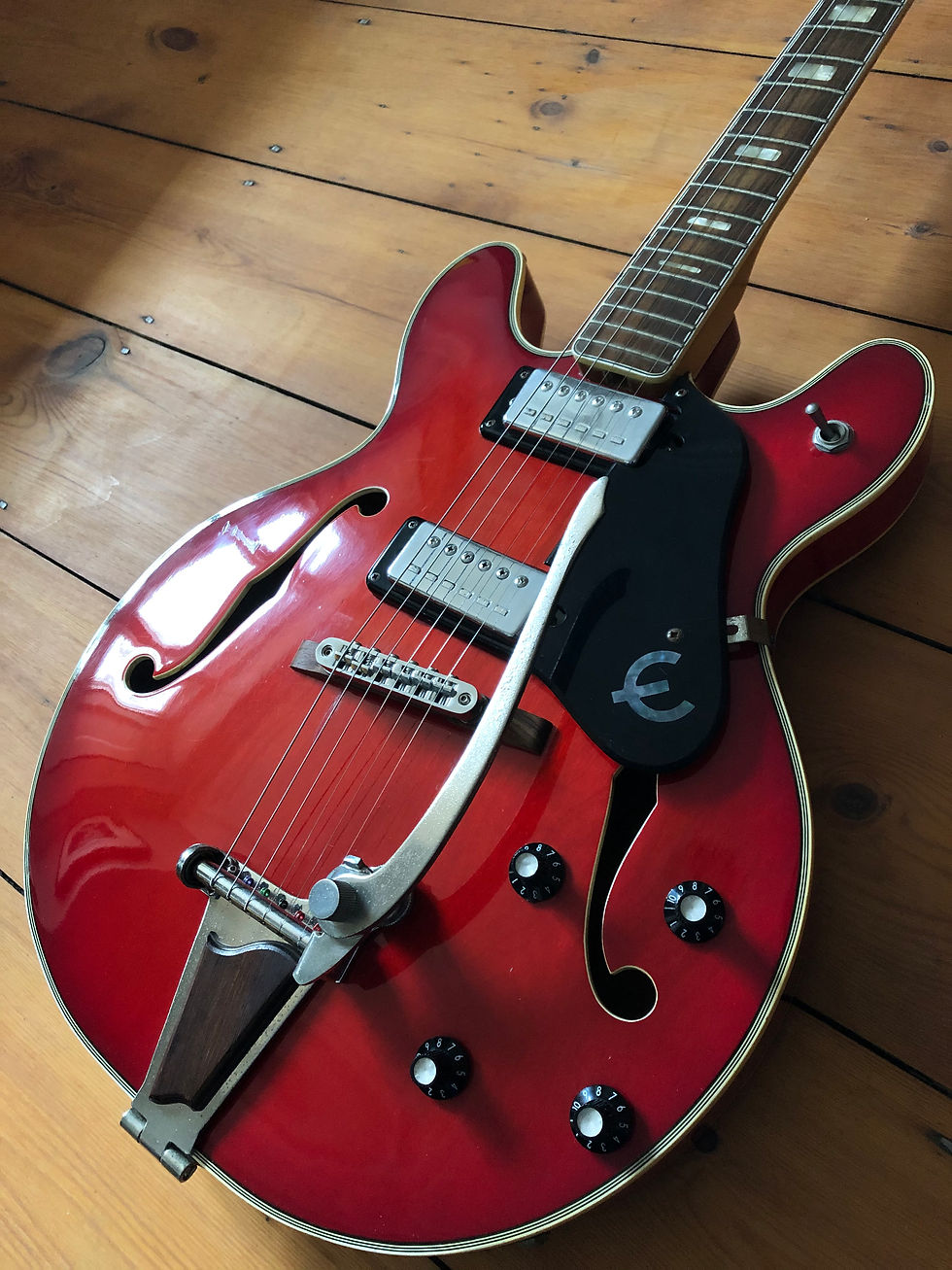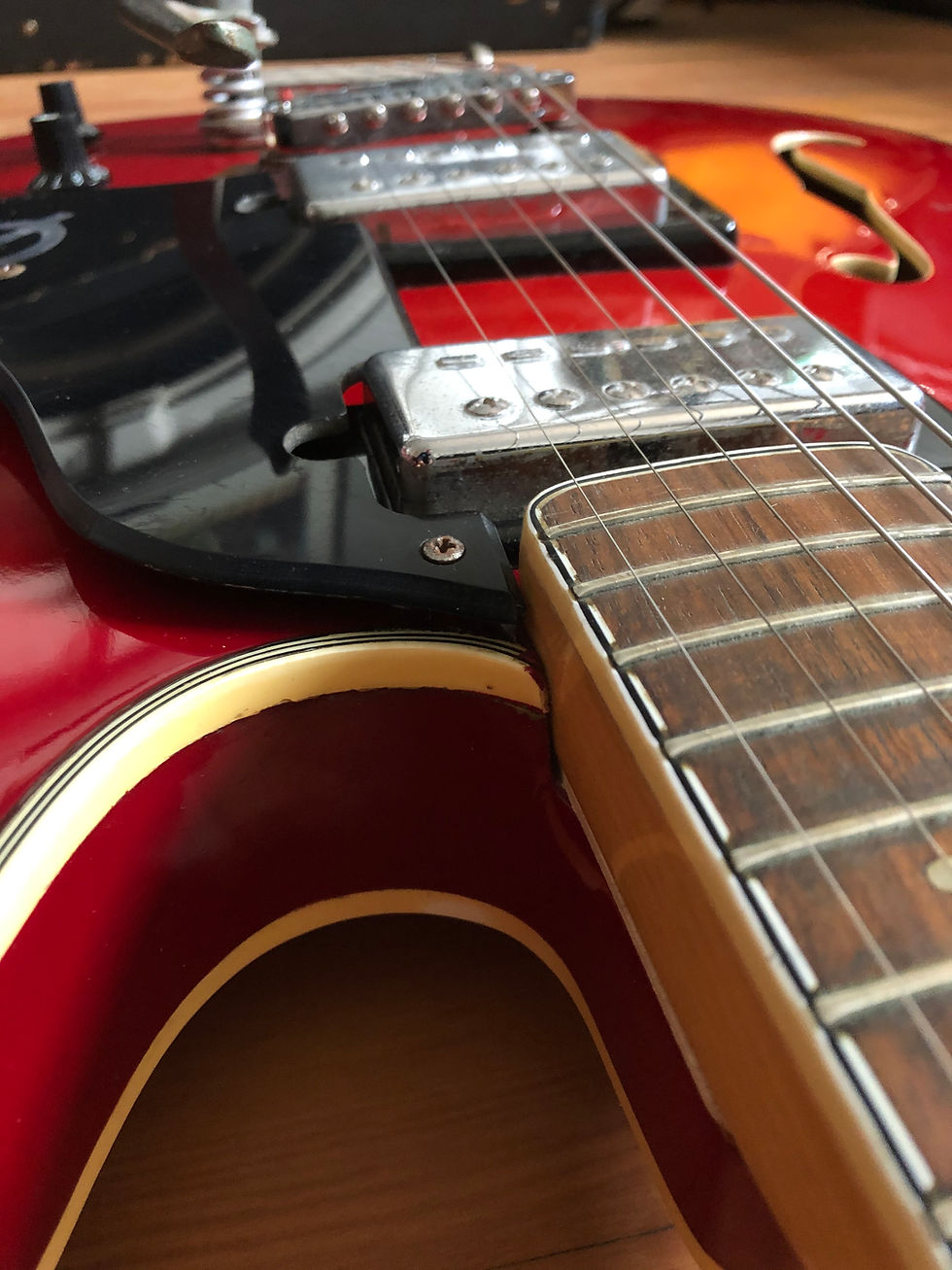1972-75 Epiphone EA-250, as made famous by Robert Smith & Noel Gallagher
From Hot, Hot, Hot to Supersonic. From last to first. As played by Robert Smith on last ever The Tube, and by Noel Gallagher on Oasis debut single, Supersonic. One of the very first Japanese Epiphones, the iconic and eye-catching EA-250.
Resilience. Of all of the famous and iconic guitar brands, I'd say Epiphone holds the crown for resilience. From boom to bust (or near-bust), not once, but with almost determined regularity, across the decades. That is, at least, until the 1990s, when things all seemed to come together to create the momentum that has broken Epiphone free of the rollercoaster. A story best told by Epiphone.
But it's one of those near-bust moments which sets the scene for the transition to Japan in 1970, as Gibson decided to shut down all Epiphone production in the US. So little were Gibson investing at the time, the early Japanese production consisted of putting the Epiphone brand on guitars that had already been designed, as originals, copies or derivatives, in the Matsumoku plant. And then selling them back in the US as Epiphones. All those classic Casinos, Rivieras, and Sheratons - all on hold until reborn in the 80s. Instead a narrow range of designs that seemed to follow the mould, but which were definitely different. Which is what makes the early models from Japan so unique. And, just like this Cherry EA-250, beauties to behold.
No surprises then that you'll see one in the hands of Epiphone-superfan Noel Gallagher in 1994, on the cover of debut single Supersonic, and live. But the story I most love is how it got to be in the hands of The Cure's Robert Smith on the last ever The Tube. I so hope it's true. For those too young to remember, The Tube ran from 1982 - 1987 - a gloriously anarchic and unpredictable music show, broadcast live, with live bands (strictly no miming). The Cure was the last band to play on the last ever The Tube. And Robert Smith is playing an EA-250. The background to that appearance might be down to Equipboard contributor Noodly, and it's a beauty: "I bought this guitar off a workmate around 1979 and was told it was about 10 years old. It had a nice thin neck and lovely feel. I was stupid to get rid of it, but a girl I fancied pretended to want to learn guitar and then persuaded me to sell it to her. A week later she told me she had left it outside Robert's parents' house as a present just before his 25th birthday on 21st April 1984, a week before the last Tube episode on 27th April 1984. He sent her a letter thanking her for the present and confirming he played it on the Tube."
Noodly's story may not be entirely true. It's definitely not accurate. Robert Smith's 25th birthday was indeed on 21 April 1984, but the last ever Tube wasn't until three years later, in 1987. So you won't find the post on Equipboard any more. But it's such a perfectly British, perfectly thwarted love story, I still hope it's somehow true. The girl got a thank you letter. Noodly didn't get the girl. But he got to tell the story, and he didn't give her the guitar for free (which is probably enough of a clue that it was never meant to be, Noodly). And we get to see the EA-250 in the hands of Robert Smith. Glorious times. Now, it's time to put it into your hands!
See & Hear It In Action
-
The Cure on Last Ever The Tube (1987): Not just Hot, Hot, Hot, but Catch and Why Can't I Be You, entirely live - and the stationary light soloing that.suits this EA-250 perfectly. A fitting finale for The Tube.
-
Oasis, Something For The Weekend (1994): Good things come in threes. Right at the beginning, Spring 1994. Rock And Roll Star, Supersonic and Shakermaker. I've got a feeing from the mix that it's only the vocals that are live (oh, and the fact that Noel doesn't seem to be playing at all during some of the solos). But still, it's a fitting beginning for Oasis and the glory that's to follow.
-
Noel Gallagher's Epiphone EA-250: If you want to see and hear more about the very EA-250 that Noel owned and played, check out high-end memorabilia dealer and Oasis fan Laurence Carpenter at Pop Icons. Wonderful insight! And if you want to see how much he sold it for in 2024, swipe down to Sources & Links!
-
Scott St Dennis Demos The EA-250: Especially good at showing off that light tremolo shimmer and an uncanny Malcolm Young AC/DC overdrive.








Feedback
Specification
Make
Epiphone
Model
EA-250
Colour
Cherry
Year
1972 - 1975
Serial Number
239437
Number of Frets
21
Fretboard
Rosewood
Neck
Maple
Body
Maple Laminate
Tuners
2 x 3-on-plate open gear
Pick-ups
Epiphone double-coil humbuckers
Bridge
Precision Tune-O-Matic,
Rosewood sculpted plinth
Tailpiece
Bigsby-style Vibrato
Scale Length
24.75"
Full Length
40.5"
Further Information:
-
Looks-wise, this guitar's got it all. That beautiful Cherry Red body, contrasting perfectly with the natural maple neck, the 6-layer body top binding, the 3-layer fretboard binding, squat 60s style headstock, mother-of-pearl inlays, the Bigsby-esque tremolo, with carved wooden harp insert, and those uniquely sized humbuckers (something between a humbucker and a P-90), already retro-style by the early 70s.
-
In fact, many of the ingredients that go into the great builds Matsumoku were putting out towards the end of the 70s and into the 80s. Check out this later 1984 Epiphone Sheraton for a full glory example.
-
The truth is, those eye-catching 70s looks were not entirely matched by playability. Which, as I started to research this one, was not unique to the EA-250 I had. The combination of a bolt-on neck, floating bridge, and tremolo don't lend the guitar to perfect intonation or stable tuning all the way up the board.
-
True to that design, when I first got this guitar, you could comfortably drive a compact 4x4 between the fretboard and the strings. OK, it wasn't quite that bad, but unless you were an accomplished slide player, this would have been one of those guitars that famously put enthusiastic beginners off ever playing again. Not helped by the fact that the three bolt neck was no match for any real pressure on the tremolo (itself definitely not Bigsby-grade), so tuning and intonation were far from rock-solid.
-
Almost every review I read talked about the addition of a substantial shim (more like a wedge) to the neck/body join. Who knows what muscular players these were originally designed for, but there can't have been many that could wring beauty from this action. Many thanks to luthier John Procter for doing a wonderful job in cutting and shaping the perfect shim. It's finally a very playable guitar.
-
As for the tremolo, it's not Bigsby-grade, but it's a lot more predictable than it was after the addition of a stabilising washer. If you're looking for warm vibrato shimmer over shred-head dive-bombing, then this delivers beautifully.
-
Best of all, if you're one of those more stationary players (come to think of it, like Robert Smith or Noel Gallagher), then the neck's not going to give you any trouble at all.
-
In summary, don't shred, solo lightly, don't jump around, just play. And listen to what you've got in your hands - a lovely sounding thinline guitar. Those humbuckers have buckets of warmth and response - and sustain just the right side of feedback as you push the volume up. And after the addition of further shims to bring the action down, it plays beautifully - with perfect intonation all the way up the neck, with or without a capo. I'd still give it a health warning, though. Photos or video shoots, studio recording, or home practice, great. But I'd be wary of trusting this in the more dynamic environment of a gig. It's a beautiful guitar, but that adventurous design is never going to give it the stability of a properly glued-in neck and fixed bridge.
Sources & Links
-
Epiphone History & Build Locations: Epiphone's own history. In particular highlighting the near-demise of the Epiphone brand in the late 60s, with the rise in popularity of foreign-made copies, to the extent that early 70s Matsumoku-built Epiphones were rebrands of those copies.
-
EA-250 Reviews On The Gibson Brands Forum: No holds barred on the deficiencies (including the "thin and whippy" neck), and lots of love for the vintage. I'd say this is how it felt at first, but with all the work done, it's a revelation now.
-
Noel Gallagher's Epiphone EA-250 Sold By Christies for £48,000: A price that no other EA-250 ever will sell at, but there can be only one! Sold by high-end music memorabilia dealer and Oasis fan Laurence Carpenter at Pop Icons - which explains the wonderful provenance and photographic evidence that goes with this lot. And now that Noel's original is in the hand of another collector, you'll just have to make do with this one ;-).









